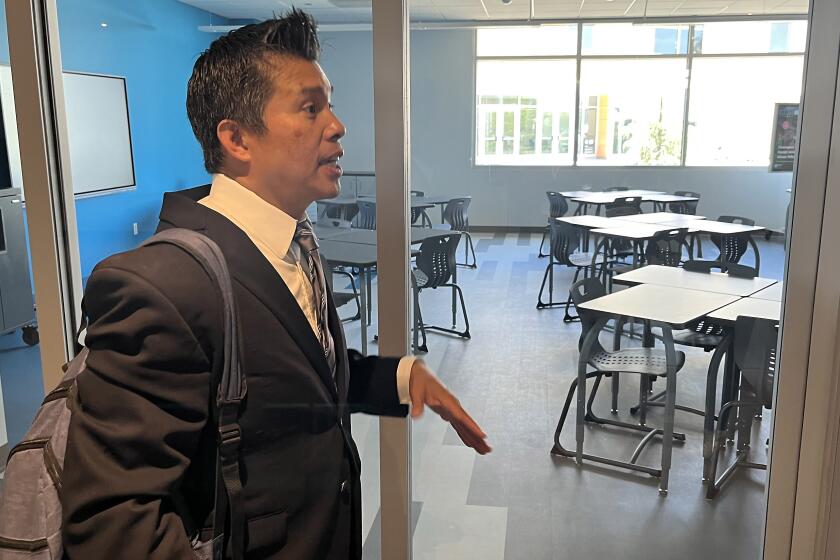Students warned USC about gynecologist early in his career: ‘They missed an opportunity to save a lot of other women’
- Share via
After an appointment with Dr. George Tyndall in 1995, USC undergraduate Alexis Rodriguez wrote a letter of complaint on a typewriter in the English department. The gynecologist, she recalled writing, had a Playboy magazine on his desk, used a scalpel on a vaginal abscess without anesthetic and, when she objected, marked her chart with the word “difficult.”
A student health clinic administrator sent back a letter, apologizing and pledging to remove the notation from her chart, Rodriguez said. It would be 21 years before the university forced Tyndall out of the clinic.
“They missed an opportunity to save a lot of other women from his mistreatment,” said Rodriguez, now 46 and a federal probation officer in Los Angeles.
The USC Board of Trustees’ executive committee announced Wednesday that outside attorneys would conduct an independent investigation into the Tyndall matter. The inquiry is to examine not only the physician’s behavior, but also what the trustees called “reporting failures” that allowed Tyndall to remain at the clinic for 27 years and treat tens of thousands of students.
As more women come forward, there is mounting evidence that employees at USC received serious warnings about Tyndall beginning early in his career. In interviews and court filings this week, former patients and colleagues described attempts to alert clinic administrators and others at the university.
Some interviewed said it was common knowledge on campus that Tyndall should be regarded with suspicion. A 2014 graduate said she even made her disconcerting visit with the gynecologist the subject of a theater class performance.
The earliest complaint shared with The Times dates to 1991 — two years after Tyndall joined the clinic staff — and was outlined in an affidavit. The unnamed alumna wrote that she told a clinic medical director and the university women’s advocacy office that Tyndall had photographed her naked without consent.
“Nothing ever came of it,” the alumna wrote.
FULL COVERAGE: USC former gynecologist Dr. George Tyndall accused of inappropriate behavior »
After The Times sent USC detailed questions about Tyndall earlier this month, the university acknowledged that the clinic’s former executive director Lawrence Neinstein, who died in 2016, had received complaints about the physician as far back as 2000. The university said that Neinstein handled Tyndall “independently,” and that based on a review of the “concerning” complaints it was not clear why the physician was allowed to stay at the clinic. Last week, two longtime supervisors at the clinic were fired.
Former patients have said Tyndall improperly touched them during pelvic exams, asked prying questions about their sex lives and made suggestive and sometimes lewd comments about their bodies. The Los Angeles Police Department and the state medical board have launched investigations, and about 300 people have contacted a USC hotline and online portal established to collect reports from former patients.
Tyndall, 71, defended his patient care in a series of earlier interviews with The Times. He said he dedicated his career to “Trojan women” and provided care that was more thorough than that of many colleagues, but never inappropriate.
The physician also insisted that before 2013, the only complaint about his care that he knew of came from a patient alleging he examined her without gloves. Tyndall said he was absolved of wrongdoing after an internal investigation.
Tyndall joined USC in the summer of 1989, and within a few years, he already had a reputation in dorms and sorority houses. An alumna who worked as a resident advisor in 1991 and 1992 said she counseled young women residing on her floor about him and offered to accompany them to appointments.
“We would specifically give his name to students and say if you are given an appointment with this doctor, we recommend you ask for a nurse practitioner,” said the alumna, who is now a lawyer in Los Angeles and spoke on the condition of anonymity.
Medical assistant Anita Thornton said she complained to a clinic administrator in the mid-1990s about the photographs he was taking of patients.
“I said, ‘I don’t want to work with him because he is not right with the girls,’” Thornton said.
Tyndall had three cameras in his office, she said. Two seemed specifically designed to take pictures of patients’ cervixes, she said, but the third was “a professional Canon-type camera with a lens on it.” Tyndall kept it in a locked cabinet, she said.
She said the administrator listened to her, but her response was noncommittal: “I’ll look into it, Anita.”
Tyndall told The Times he had two cameras in the office and photographed patients for legitimate reasons. He said he stopped taking pictures in the exam room because it was controversial with chaperones.
Thornton said in the late 1990s or 2000, she was part of a group of medical assistants who complained to another supervisor during a staff meeting. She said they were upset that Tyndall wanted the assistants chaperoning his appointments to stand on the other side of a curtain while he performed pelvic exams. She also objected to what she saw as a “creepy” manner of using his fingers during the exams as well as comments he made to students.
“We said he is disgusting and no one wants to work with him,” she recalled. The supervisor listened, but there was no indication of an investigation and Tyndall’s behavior continued, Thornton said.
Alumna Meggie Kwait said she complained about Tyndall after a 2008 appointment that left her in tears. She said Tyndall seemed fixated on her weight and the fact that she’d had sexual encounters with both men and women. At the start of the pelvic exam, Kwait said, the doctor inserted his fingers inside her and said, “I bet you’re pretty used to this.”
She said Tyndall urged her to lose weight and told her that if she became skinnier, she could probably “get a guy instead of a girlfriend.”
She described Tyndall’s remarks and demeanor on a comment card and submitted it to the clinic. She said she did not recall ever receiving a response.
“I wish now that I had escalated this then. I feel horrible that there were another 10 years of women who were victimized by this man,” said Kwait, now 31 and an educator in New York.
Legal papers from Tyndall’s former patients also detail reports to USC. A former graduate student now living in the Bay Area said she complained to a nurse practitioner in 2015 that Tyndall falsely told her she likely had AIDS, according to a lawsuit she filed this week.
In 1991, another USC alumna complained to the health clinic’s medical director and a female nurse after Tyndall photographed her genitals during a pelvic exam. Her anonymous account was detailed in a sworn affidavit provided by her attorney, Gloria Allred.
The alumna said Tyndall explained the camera as “a new way to do examinations instead of a pap smear,” the affidavit states. Next, he stood up and walked backwards, snapping photos of her body, she recounted in the affidavit.
The medical director told her he eventually located the camera and that Tyndall had exposed the camera’s film. In the affidavit, she described phoning a campus women’s advocacy office to lodge a complaint.
Rodriguez, who complained about Tyndall in 1995, said that after diagnosing an abscess on her vaginal wall, Tyndall attempted to lance it without an anesthetic and nicked her with a scalpel.
When she recoiled in pain, he told her to find another doctor. A USC physician outside the clinic treated her. Months later, she returned to the clinic for a nongynecological visit. As she waited for the doctor, she picked up her chart and started reading Tyndall’s account of the visit.
“It kinda bothered me that I was being called this hysterical woman,” she said. “It was a mischaracterization of what had happened.”
She said she no longer has USC’s response or a copy of her complaint, but provided The Times with another letter she wrote in 1995 referencing the abscess and a “terrible experience with a doctor on staff” of the clinic.
Madelyne Heyman, who graduated with a theater degree in 2014, said she did not report Tyndall after an “uncomfortable” visit her junior year. She said he pressed her about her virginity in a way that made her feel ashamed and insecure. But she said the experience haunted her, and in her final semester she turned it into a piece of performance art for one of her classes.
“I played myself and him,” said Heyman, now 26 and a writer. She said she did not use Tyndall’s name, but when she performed at a campus showcase, “other women came up to me and said they had a similar experience.”
harriet.ryan@latimes.com | Twitter: @latimesharriet
matt.hamilton@latimes.com | Twitter: @MattHjourno
Times staff writer Sarah Parvini contributed to this report.
More to Read
Sign up for Essential California
The most important California stories and recommendations in your inbox every morning.
You may occasionally receive promotional content from the Los Angeles Times.















